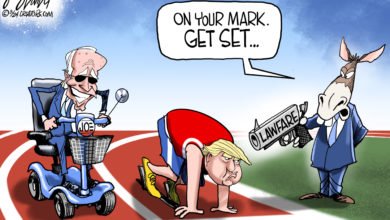Here’s why Trump’s announcement of 25% tariff on Chinese goods won’t end in trade war
President Donald Trump announced Friday that his administration would levy tariffs against China in response to decades of unfair trade practices and theft of American intellectual property. China has threatened retaliation, but there is little chance for a full-blown trade war.
“Trade between our nations, however, has been very unfair, for a very long time,” the president said in a statement. “This situation is no longer sustainable. China has, for example, long been engaging in several unfair practices related to the acquisition of American intellectual property and technology.”
China has threatened retaliatory trade restrictions in response to Trump’s “America First” trade policies. Their response is illogical as their country has far more to lose than the United States should a full-on trade war break out.
Why a trade war is a loser for China
There are two major components of trade with China. First, is the direct sale of goods:
- If America was unable to sell a single good to China, only 1.2% of its GDP would be impacted
- If China, the world’s largest exporter, was unable to sell any goods to the United States, it would lose 25% of its export income which makes up 18% of its economy which would negatively impact China’s economy by about -4.5%
Secondly, many U.S. companies export raw materials or components to China to have them cheaply assembled then re-imported to the United States. A trade war would make this competitively infeasible and result in American companies insourcing the work to U.S. factories. Goods would become more expensive in the United States, but good paying jobs and wage pressure from a tight labor market would increase pay – something the American economy has struggled to do on its own for decades. China would also lose a major source of employment. Without all those components coming in to be assembled by lower-class workers, China’s GDP would be further negatively impacted with America’s skyrockets. To avoid tariffs and the loss of revenue to its economy, China might also be forced to move facilities to the United States and hire American workers to avoid having its Gross National Product (GNP) also adversely affected. Either way, China GDP would take a serious hit while the United States sees a boost to its already quickly increasing domestic output.
Conversely, U.S. GNP would remain largely unscathed. China has huge barriers to foreign investment and is considering increasing those barriers in response to Trump’s demand for fair trade conditions.
How bad is the trade imbalance with China?
The U.S. trade imbalance with China was $375 billion in 2017 as China exported more than $500 billion to the United States while importing only $130 billion from the U.S. While China enjoys a massive surplus against the U.S., it still employs massive tariffs (30% or higher) on digital video devices, raisins, motorcycles and more.
On top of tariffs, China also assesses a Value Added Tax on imported American goods while the U.S. imposes no such tax on Chinese imports. The Chinese government often “adjusts” VAT rebate levels, a rebate to Chinese companies for exports, to fulfill marketplace policy goals.
The president cited the intellectual property theft and importation taxes/duties as good reason to implement a 25% tariff on a list of 800 Chinese imports.
“In light of Chinas theft of intellectual property and technology and its other unfair trade practices, the United States will implement a 25 percent tariff on $50 billion of goods from China that contain industrially significant technologies,” Trump said. “This includes goods related to Chinas “Made in China 2025″ strategic plan to dominate the emerging high-technology industries that will drive future economic growth for China, but hurt economic growth for the United States and many other countries.”
The United States Trade Representative (USTR) documented China’s unfair practices in a March report.
The president’s statement did not reveal when the tariffs would go into effect, but if past is prologue, a 30-day waiting period is likely. This will give China time to negotiate with U.S. representatives so that American intellectual property is safeguarded and a more fair trade relationship is gained. If China seeks to retaliate instead of negotiating, the results may not be to their liking.
“The United States will pursue additional tariffs if China engages in retaliatory measures, such as imposing new tariffs on United States goods, services, or agricultural products; raising non-tariff barriers; or taking punitive actions against American exporters or American companies operating in China,” Trump added.
A trade war isn’t imminent
China, the EU, Mexico and Canada have all threatened to escalate a trade war with the United States, but just as China would, the export economies of the EU and Canada would be more negatively impacted than the import economy of America. In fact, should those countries make U.S. exports less welcome or boycott American products and services, another “Made in America” nationalization drive along with more expensive imports, would internalize U.S. consumption leading to more jobs at home, higher wages for American families, U.S. dollars going to other countries, and less access to a red-hot economy for those three trading partners.





Tariffs ARE one of the Constitutional means of raising revenue for the federal government!
“Fair Trade” isn’t easy to understand and someone always gets a bigger piece of the pie. It’s a problem when they want it all…..and that’s apparently what China, Canada & Mexico want. “One for you, two for me” has been a practice they feel is ‘deserved’.
True, it may create a temporary hardship on some, and that’s a shame. If we want something and feel the price is ridiculously high…..do we pay or do without.
In 2006, the USA accounted for 65% of Mexico’s GNI and some 450 American companies were doing business in Mexico.
Currently, we account for 22% of Canada’s GNI……they to ours a mere 2%
In 1996 Bill Clinton worked to get China into the free market and we’ve paid dearly ever since.
It may be like a new pair of shoes the pinch until you wear them awhile….then love them.